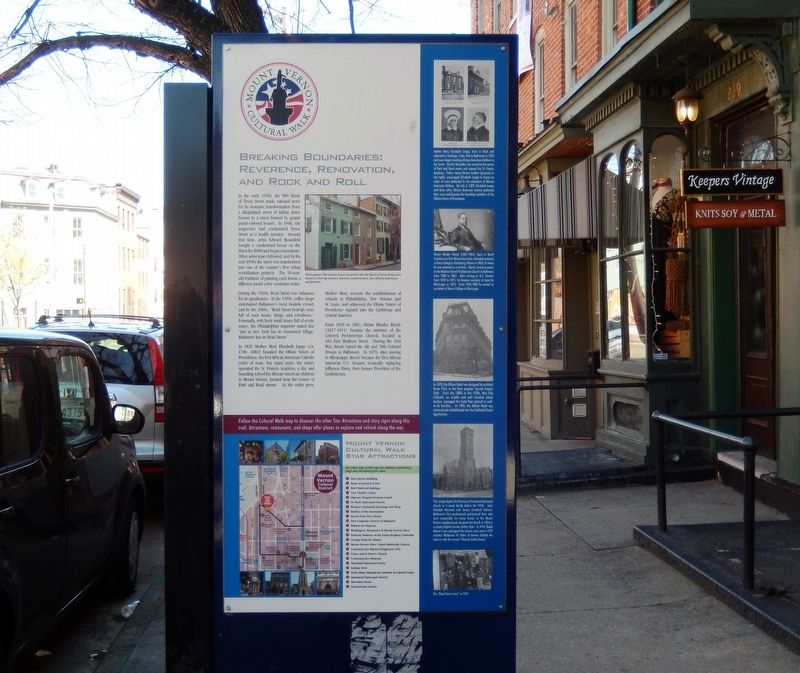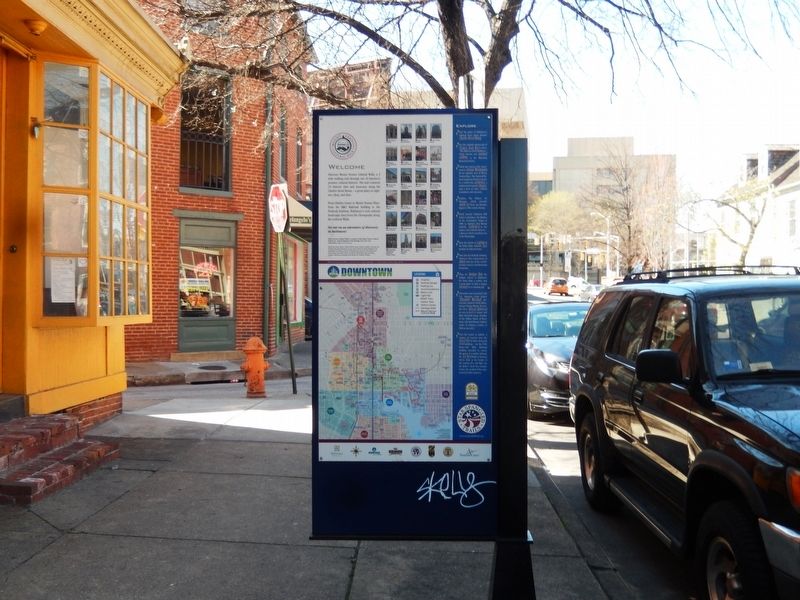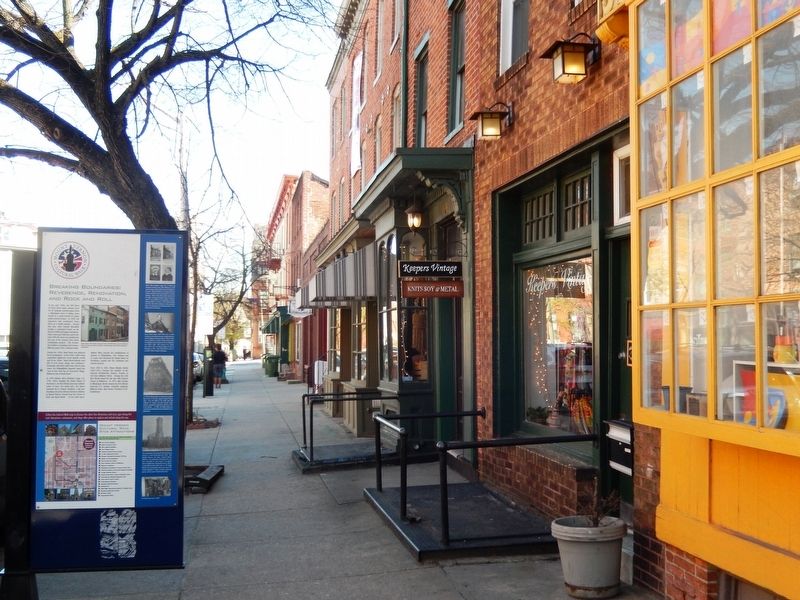Mount Vernon in Baltimore, Maryland — The American Northeast (Mid-Atlantic)
Breaking Boundaries: Reverence, Renovation, and Rock and Roll
Mount Vernon Cultural Walk
Inscription.
In the early 1950s, the 900 block of Tyson Street made national news for its dramatic transformation from a dilapidated street of falling down houses to a street framed by quaint pastel-colored homes. In 1948, City inspectors had condemned Tyson Street as a health menace. Around that time, artist Edward Rosenfeld bought a condemned house on the block for $800 and began renovations. Other artist-types followed, and by the mid-1950s the street was transformed into one of the country’s first urban revitalization projects. The 50-year old tradition of painting each house a different pastel color continues today.
During the 1920s, Read Street was infamous for its speakeasies. In the 1950s, coffee shops entertained Baltimore’s local beatnik crowd, and by the 1960s, “Read Street festivals were full of rock music, drugs, and rowdiness.” Eventually, with lively retail stores full of exotic wares, the Philadelphia Inquirer stated that “just as New York has its Greenwich Village, Baltimore has its Read Street.
In 1829 Mother Mary Elizabeth Lange (ca.1780-1882) founded the Oblate Sisters of Providence, the first African American Catholic order of nuns. For many years, the sisters operated the St. Francis Academy, a day and boarding school for African American children in Mount Vernon, located near the corner of Park and Read streets. As the order grew, Mother Mary oversaw the establishment of schools in Philadelphia, New Orleans and St. Louis, and witnessed the Oblate Sisters of Providence expand into the Caribbean and Central America.
From 1858 to 1863, Hiram Rhodes Revels (1827-1911) became the minister of the Colored Presbyterian Church, located at 104 East Madison Street. During the Civil War, Revels raised the 4th and 39th Colored Troops in Baltimore. In 1870, after moving to Mississippi, Revels became the first African American U.S. Senator, ironically replacing Jefferson Davis, then former President of the Confederacy.
[Captions:]
These quaint 19th century houses located in the 900 block of Tyson Street were homes to Irish rug weavers, laborers, washerwomen, free African Americans, and painters.
Mother Mary Elizabeth Lange, born in Haiti and educated in Santiago, Cuba, fled to Baltimore in 1813 and soon began teaching African American children in her home. Shortly thereafter, she moved to the corner of Park and Read streets, and opened the St. Francis Academy. Father James Hector Joubert (pictured on the right), encouraged Elizabeth Lange to found an order of nuns dedicated to the education of African American children. On Jul 2, 1829, Elizabeth Lange and three other African American women professed their vows and became the founding members
of the Oblate Sisters of Providence.
Hiram Rhodes Revels (1827-1901), born in North Carolina as a free African American, attended seminary at Knox College in Galesburg, Illinois in 1856-57 where he was ordained as a minister. Revels served as pastor to the Madison Street Presbyterian Church in Baltimore from 1858 to 1863. After serving as U.S. Senator from 1870 to 1871, he became secretary of state for Mississippi in 1873. From 1876-1882 he served as president of Alcorn College in Mississippi.
In 1879, the Albion Hotel was designed by architect Bruce Price in the then popular Second Empire Style. From the 1880s to the 1920s, Miss Ella Culbreth, an --- and well traveled school teacher, managed the hotel that catered to well-to-do-families. In 1983, the Albion Hotel was restored and rehabilitated into the Cathedral Court Apartments.
This image depicts the Emanuel Protestant Episcopal Church as it stood shortly before the 1910s. John Rudolph Niernson and James Crawford Neilson, Baltimore’s first professional architectural firm, who were responsible for many houses in the Mount Vernon neighborhood, designed the church in 1854 in a simple English Country Gothic Style. In 1914, Ralph Adams Cram redesigned the interior nave and in 1919 architect Weldemar H. Ritter of Boston clothed the exterior with the current “Flemish Gothic Greenery.
The “Read
Street scene” in 1967.
Topics. This historical marker is listed in these topic lists: African Americans • Arts, Letters, Music • Education • Entertainment. A significant historical date for this entry is July 2, 1829.
Location. 39° 18.035′ N, 76° 37.155′ W. Marker is in Baltimore, Maryland. It is in Mount Vernon. Marker is on West Read Street. Touch for map. Marker is at or near this postal address: 231 West Read Street, Baltimore MD 21201, United States of America. Touch for directions.
Other nearby markers. At least 8 other markers are within walking distance of this marker. Eubie Blake National Jazz Institute and Cultural Center (about 400 feet away, measured in a direct line); Educating Baltimore: Music, History and Academia (about 400 feet away); Henry August Rowland House (about 500 feet away); Trinity African Methodist Episcopal Church (about 600 feet away); Tyson House (about 600 feet away); The Professional Arts Building (about 600 feet away); Emmanuel Episcopal Church (about 700 feet away); The Revels (approx. 0.2 miles away). Touch for a list and map of all markers in Baltimore.
Credits. This page was last revised on March 23, 2024. It was originally submitted on April 17, 2017, by Don Morfe of Baltimore, Maryland. This page has been viewed 283 times since then and 12 times this year. Photos: 1, 2, 3. submitted on April 17, 2017, by Don Morfe of Baltimore, Maryland. • Bill Pfingsten was the editor who published this page.


